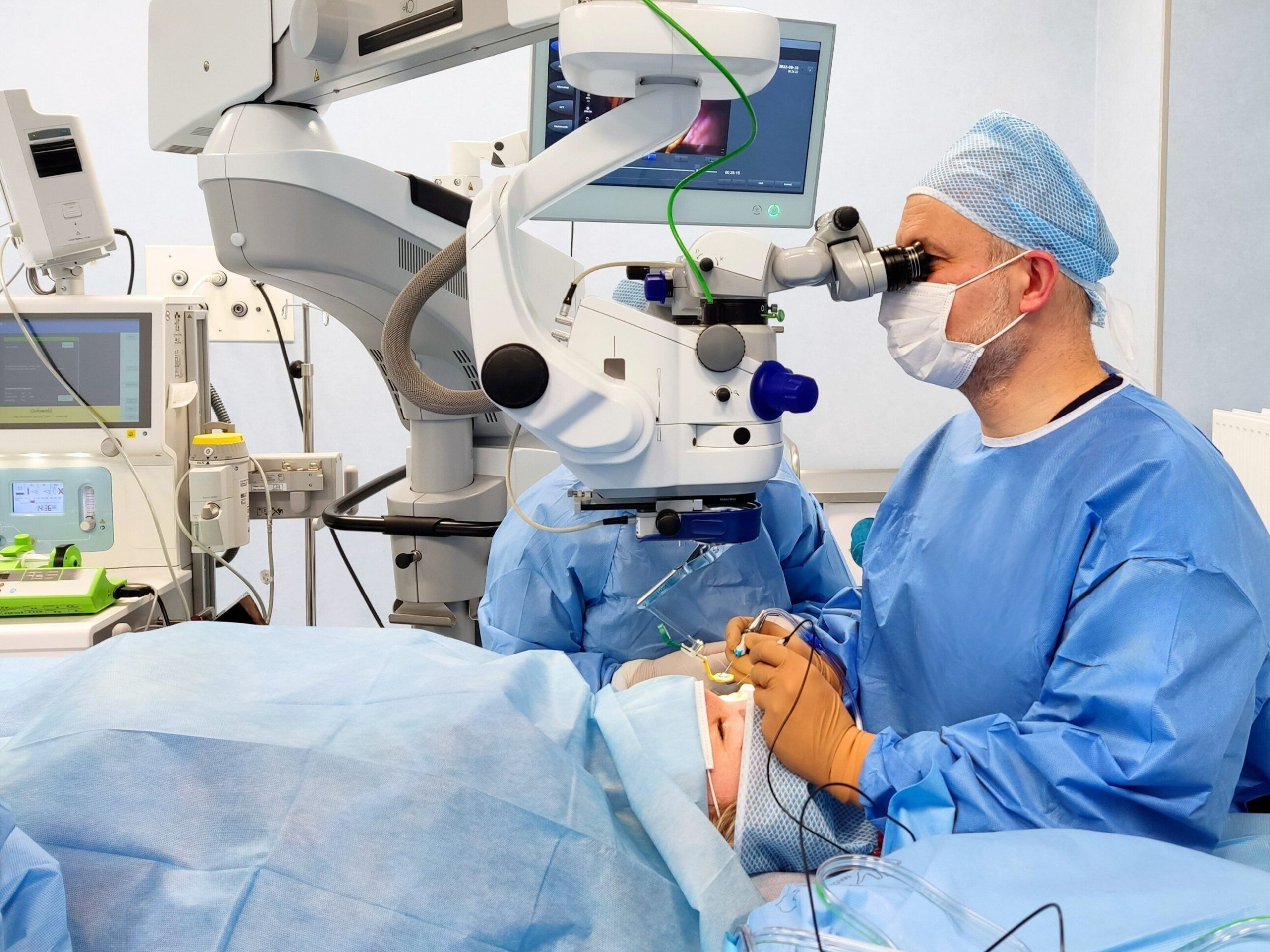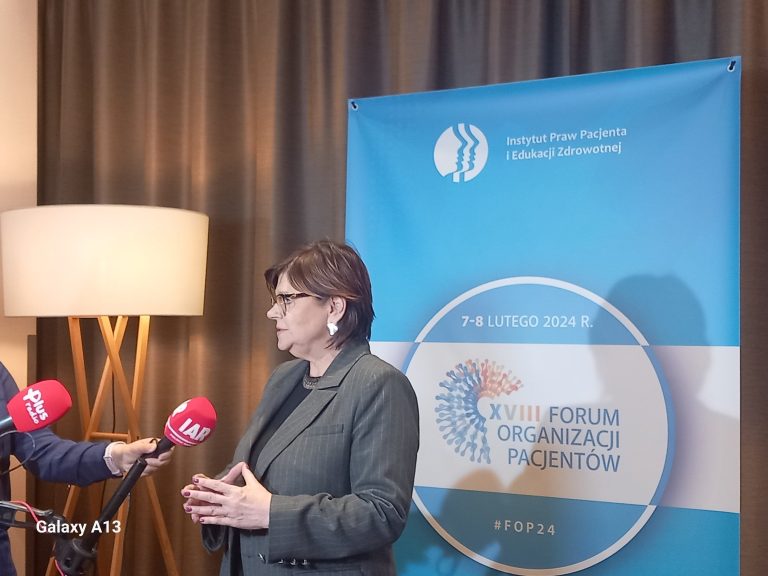Gene therapies – modern methods of treating eye diseases

Everything indicates that some eye diseases, which until recently were considered incurable and leading to blindness, will be able to be remedied. With the development of modern treatment methods in ophthalmology, which undoubtedly include gene therapies, new possibilities have opened up. Clinical trials using gene therapies are still ongoing, but their results look very promising, especially in the context of the treatment of retinal diseases and genetic diseases of the eye.
The first surgery in Poland using gene therapy to treat age-related macular degeneration (AMD) took place in August 2022. It was performed by prof. Dr. hab. n. med. Jakub Kałużny from the Oftalmika Ophthalmological Clinic in Bydgoszcz as part of phase II clinical trials. The surgical procedure was performed on a patient with diagnosed geographic atrophy. It was also the second surgery in our country using gene therapy to treat eye diseases (the first one was performed by Prof. Marcin Stopa in 2021).
The era of gene therapy in ophthalmology began even earlier in the world – in 2017, with the registration of the first drug used in gene therapy in patients with retinal dystrophy caused by a mutation of the RPE65 gene. Mutations in this gene are responsible for the occurrence of a rare disease – Leber’s congenital amaurosis. The drug, which is administered by subretinal injection, stimulates retinal cells to produce the missing protein, which permanently improves retinal function. Due to the need to create centers where it would be possible, among others, conducting clinical trials of new gene drugs, the Genetic Engineering Department at the Oftalmika Clinic in Bydgoszcz was opened in 2022 – one of the first in Poland. Currently, clinical trials of two such drugs are underway, which are intended to inhibit the development of a serious disease – geographic atrophy due to AMD, a common cause of blindness in adults around the world.
A dangerous retinal disease – AMD
The retina is a delicate membrane inside the eye. Its task is to convert light stimuli into electrical impulses transmitted to the brain. Retinal impairment can make everyday life very difficult. One of the dangerous diseases of this part of the eye is age-related macular degeneration (AMD). It occurs in a dry form, which in the advanced stage leads to geographic disappearance, and in a wet (exudative) form. Both types of disease cause loss of central vision. This disease is the leading cause of blindness in older people. Unfortunately, estimated statistics show that the number of people suffering from AMD in the world is expected to double over the next 30 years.
– During the disease, there is extensive loss of retinal pigment epithelium cells, photoreceptors and choroid capillaries, which causes difficulties, for example, in telling the time, reading, and driving. The patient retains only peripheral vision. Geographic atrophy usually develops slowly and in both eyes, causing irreversible changes. In people affected by AMD, vision gradually deteriorates and the image becomes distorted. In the advanced stage of the disease, there is a significant decrease in visual acuity and even loss of central vision – says prof. Ph.D. med. Jakub Kałużny from the Oftalmika Ophthalmological Clinic in Bydgoszcz.
The estimated number of AMD patients in Poland is 1.5 million, of which the dry form accounts for 90% of cases. However, more than 8 million people around the world suffer from geographic atrophy. It is worth emphasizing that the risk of the disease is greater in patients who smoke cigarettes, people with high cholesterol levels and arterial hypertension. According to the latest scientific research, genes are an important risk factor for the development of AMD. Several dozen genes have been identified that predispose to the development of this disease.
The disease often runs in families, so descendants of sick people are at greater risk of developing the disease. Currently, there are quite effective drugs that inhibit the development of wet AMD. These drugs, belonging to the group of substances that block vascular endothelial growth factor (antiVEGF), are administered by injection into the eye at regular intervals. We have a very well-functioning drug program in Poland financed by the National Health Fund for this therapy. Unfortunately, in the case of geographic disappearance, the situation is different. This year, the first drug that inhibits the progression of the disease was registered in the USA, but it does not allow the reconstruction of the damaged retina and is not yet available in Europe. In such a situation, scientific research comes to the rescue, thanks to which new drugs are created that can not only stop the development of geographic atrophy, previously considered an incurable disease, but even improve visual acuity.
Modern therapies and clinical trials
Introducing new drugs is a very complex, long-term and expensive process. The final stage of this process is clinical trials, which aim to test the safety and effectiveness of potential new drugs. Such research, thanks to which it is possible to implement new and effective methods of treating eye diseases previously considered incurable or curable only to a limited extent, is conducted by specialized ophthalmological centers.
– Our clinic conducts many research projects concerning not only gene therapies, but generally – modern therapies in the treatment of eye diseases. Patients may participate in clinical trials for: wet age-related macular degeneration (AMD), geographic decay (GA), uveitis, retinal vein clots and atopic dermatitis (AD – dermatological program). Thanks to research conducted, among others, In our clinic, patients can now use many modern drugs for the treatment of AMD that have been registered in recent years – adds prof. Ph.D. med. Jakub Kałużny.
Viruses in the service of gene therapies
The idea behind gene therapy is to fix the problem at the source. On the one hand, the damaged gene can be replaced with a healthy one, on the other – it can be neutralized, and on the third – a specially modified gene can be introduced that supports the healing process. After introducing the genetic material directly into the cells, the proteins encoded by a given gene are synthesized, which change the cell metabolism in such a way that the disease is inhibited, which in the case of eye diseases often results in improved vision. In order to deliver a given gene to appropriate cells in the eye, common, previously neutralized viruses are used, specifically their structure and ability to penetrate cells. This is how a modified version of the virus is created – adenovirus (AAV), not associated with any disease, commonly used in gene therapies. Viral DNA, i.e. the part of the virus that causes infections, is replaced with a gene coding for a specific protein. However, it must be remembered that gene therapy is only in the initial phase of development and so far several dozen gene drugs have been registered worldwide, including only one used to treat eye diseases.
However, many phase I and II clinical trials are being conducted on new preparations. In the case of geographic atrophy due to AMD, gene therapy involves a single administration under the retina or into the vitreous body of a viral vector with genes that inhibit inflammation in the outer layers of the retina. Theoretically, such treatment slows down the progression of the disease and inhibits the process of retinal atrophy, which allows vision to be preserved in patients suffering from this incurable disease. Whether this is actually the case will be assessed by phase III clinical trials, the results of which we will have to wait a few more years for.
A promising future for gene therapies
Gene therapy appears to be the future of medicine and a powerful tool in the field of research on eye diseases, but it is burdened with many challenges. Currently, it is a very expensive therapy (expensive tests and equipment), difficult to access, and still in the research phase. Despite this, its development looks very promising. The number of clinical trials conducted around the world to confirm the safety and effectiveness of new therapies is constantly increasing. Centers are also being established where it becomes possible to carry out this type of research – e.g. the already mentioned Department of Genetic Engineering at the Ophthalmika Ophthalmological Clinic in Bydgoszcz.
– The development of new technologies, which are of great importance for the progress of gene therapies, is also gaining momentum. One thing is for sure – gene therapy offers great hope for improving the quality of life of patients suffering from previously incurable eye diseases – says prof. Ph.D. med. Jakub Kałużny. In the case of some retinal diseases, correcting genetic defects is the only solution to maintaining vision. Gene therapies will certainly not be an antidote for solving all medical problems, but they will help slow down the progression of some diseases or even cure them completely.
Biographical note
Prof. Ph.D. n. med. Jakub Kałużny is the head of the Oftalmika Ophthalmological Clinic in Bydgoszcz and the head of the Department of Sensory Organ Research at the Collegium Medicum in Bydgoszcz, Nicolaus Copernicus University in Toruń. His main field of interest is the diagnosis and treatment of retinal diseases. In the years 2000-2008, he participated in the work of an interdisciplinary team on the creation of a prototype device for spectral optical tomography, which was implemented into production under the name SOCT Copernicus (as the first device of this type in the world). He is the author of over 90 publications and numerous presentations at domestic and foreign conferences.






